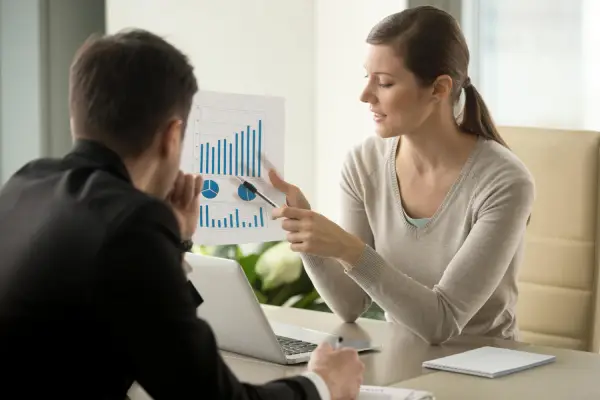During the pandemic, events looked a little different. Many of us traded our annual conference trips to a virtual setting, with webinars replacing in-person meetings. But the tide is beginning to turn.
According to data from LinkedIn, 75% of event marketers will continue to host virtual events a year from now, but 78% said they wanted in-person events to return to a primary role once it’s safe for them to do so.
With in-person events beginning to make a comeback, it’s important for marketers to leverage B2B contact data before, during, and after events in order to engage with prospective customers.
Pre-Event Prep Work
Before an event, your main goal is to focus on prospecting to grow your attendee list and capture the proper audience. You may be looking for new prospects to connect with and local companies that you’ve had your sights set on. Maybe you’re simply casting a broad net to enter a new market.
Whatever the case may be, you have some preparation to do in order to make your in-person event a success. There are many ways to leverage your B2B contact database to do so.
1. Attract an Audience
One of the best ways to grow your audience is to start with the list of event registrants if it’s available to you. You can use this data to map out your buying center and run relevant marketing campaigns.
Based on the quantity and quality of registrants, you can see if you’re meeting your goals and adjust your messaging accordingly. After companies complete the registration form, you can dive in to see if you’re capturing the right businesses, industries, and job titles. Based on your findings, you can cater personalized messaging to them, sparking interest.
In some cases, especially conferences, you won’t know who’s coming until the day of (or even after) the event. When that happens, you have a few options. First, leverage your existing audience. Have companies that you’re interested in shared that they’re planning to attend on social media? That’s a great indicator. You can also try running a specific campaign based on the topic of the event.
2. Decipher Intent
If you’re utilizing a B2B data provider that offers it, be sure to take advantage of intent data. Look for intent signals with your event to find companies who might be interested in attending, but are not registered attendees or might not have the budget to attend.
If you’re serious about a specific prospect who hasn’t made the final commitment, you can offer to subsidize their attendance in some way, whether it’s a discounted rate or inviting them to attend for free as your VIP.
With the added knowledge of their buyer intent data, you can target the right accounts, giving individualized attention to those who need it most. These accounts may be searching keywords related to the event and on the fence about making the final decision. That’s where you swoop in, inviting them and offering them a discount – as if you read their mind!
3. Locate the Locals
Based on the location of the event, you may want to explore the use of firmographic data. Through a firmographic filter, you can narrow down prospects based on their operating locations, whether by state, city, or a ZIP code radius search.
Try and find companies with offices near the event. Maybe they aren’t heading to the conference or show, but you can still take advantage of being local. This is an excellent opportunity to set up in-person meetings with key influencers while your team is in town, providing individualized care, solutions, and introductions, hopefully leading to a closed deal.
4. Target their Tech Stack
If your solution offers integrations with other systems or you’re trying to dissuade clients from using a competitor, you may want to look at their tech stack. A data provider offering you technographic data can provide valuable insights into the hardware or software applications used by your prospects.
Knowing which tools, and applications a company uses can enable B2B marketers and sales professionals to take a focused approach, saving a lot of time. Say you offer a product that integrates with Salesforce. It only makes sense to pursue accounts who currently use that solution. If they have no use for your offering, the conversations will end very quickly.
In addition, by cross-referencing attending companies with technographics, you can easily track changes happening in their tech portfolios to better anticipate their evolving needs. Maybe they’re looking for a new provider and are shifting away from a competitor due to a price hike, change in offerings or other dissatisfaction. Reach out and start the conversation. Meeting with them face-to-face during the event is an amazing opportunity to open the door to future deals.
Dive In During the Event
While many think of event data as arriving after the event is over, there’s plenty of B2B sales data that comes while your event is in session. Your team is connecting face-to-face and making impressions that cannot be easily replicated over a telephone call or a computer screen.
While those connections are happening is a great time to collect data – conference badges, business cards, and even social media buzz can give you a strong indication of future prospects and deals.
1. Browse Business Cards and Badges
Now that you’re back in-person again, chances are you’re going to amass quite a few business cards and see a number of conference badges. These are great to boost your existing B2B contact database and keep track of who you met at the event to continue conversations at a later date.
By using scanners, you can quickly pull contact info for people you meet into your B2B contact database. To do this, we recommend ScanBizCards to help you capture qualified B2B leads at events and conferences via business cards and badges. Through this tool, you can maximize your event’s ROI by uploading leads quickly and accurately with their CRM integration. Be sure to download their free app before you head out to your event, in case scanners are not provided by your event host.
While it’s great to collect that data, what’s more important is what is done with it. When does your team look at their collected data– event day, between days, when they return? Often overlooked, your team can leverage your B2B contact database while you’re still at the event.
If you were hoping to reach a target account that didn’t stop by, or you sparked an unexpected conversation with a fresh lead, strike while the iron is hot! You still have a chance to connect back with them, whether it’s sending a personalized email between conference days or inviting them to an informal dinner or happy hour while you’re in town. Keep the conversation going!
While you’re at the event, having a social media presence is a great way to engage with attendees or encourage them to visit your booth at a larger-scale conference. Try posting where your booth is located, who from the team to look out for, and generate some buzz to get prospects to stop by and say hello.
Based on the interactions that you receive, you can better understand buyer intent and where they are in the buyer journey. You can also encourage attendees to share their experiences and create a bit of FOMO (fear of missing out) for those who didn’t attend.
3. Post-Event Analysis
After you return from the event, you’ll likely have new leads, prospects, and contacts to import into your CRM. You may have even solicited feedback to have a greater understanding of how successful your event was.
Events aren’t cheap– especially in-person ones. In order to make sure you have a great ROI, ensure that the data you collected is being utilized and integrated properly and that you have high-quality leads.
4. Augment Data with Enrichment
No data set is perfect. Sometimes there’s data missing, outdated, or you have duplicate contact records. Once you’re back, you should enrich the data you received from the event.
If you are using an opt-in list, prospective customers may end up leaving key data fields blank, like their phone number or email address. This can also happen from your booth scans as well, as the entries may be missing or inaccurate.
Event list enrichment can allow you to append missing fields for contact records such as email, phone, company, location, or even their LinkedIn profiles. This is useful information to have, especially if it wasn’t a required field for registration or left off their business cards.
5. Validate Visitor Data
After attending the event, check to see who’s visiting your website. Did you pique some interest? Maybe some attendees are too shy to reach out directly, but you made an impression on them.
You can easily use website visitor data to identify companies visiting your site and their level of activity. You can then cross-reference attendees with the people visiting your website. Any similarities? Now you can easily qualify and convert those leads!
Do It With SalesIntel
If you’re looking for a solution to help you sort through all your event-related data– look no further! With the return of in-person events to our calendars, SalesIntel is ready to assist you in leveraging all the B2B contact data at your disposal.
As we return to in-person meetings or switch to a hybrid approach, engaging with prospects is more critical than ever. We hope to be your partner as we explore the future of events!




